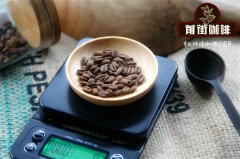Costa Rica dark red fruit sun-dried Colorado coffee beans introduction _ sun-dried Costa Rican coffee

Professional coffee knowledge exchange more coffee bean information please follow the coffee workshop (Wechat official account cafe_style)
Colorado Springs
Costa Rican coffee Tarazhu S.H.B refers to extremely hard beans above 1200 meters above sea level, which means high quality Costa Rican coffee. Suitable for medium baking and deep baking. The roasted coffee beans have full grains, weak bitterness, soft acidity, smooth and textured taste * and strong and charming flavor, in which the strong aroma of roasted drupes can make people feel calm.
Features: the flavor is extremely balanced, extremely clean, extremely clear, and fruit acid with berry flavor, excellent Costa Rican aftertaste will show spice and cocoa flavor.
In addition, deep baking treatment is still thick but not bitter. In particular, the production of milk coffee, especially sweet.
Costa Rican coffee has been cultivated for two hundred years. It was first planted on the slopes of the Poas and Barva volcanoes, today known as the Central Valley (Central Valley). The seven main coffee producing areas are distributed from northwest to southeast, along with the inland central plateau.
Costa Rican volcanic terrain with fertile volcanic ash, mild and suitable temperature, and stable and abundant rainfall is one of the factors why coffee has become one of the main agricultural products in Costa Rica. The seven major producing areas are: Tarrzu, Tres Rios, Orosi, Central Valley, West Valley, Turrialba and Brunca.
Its three most famous producing areas are Tarasu, south of the Costa Rican capital SanJose, as well as the producing areas of the Central Valley and the western valley. Among them, there are many excellent independent estates, all of which are carefully cultivating more fine washing and honey-treated coffee beans.
Costa Rican coffee has a unique natural environment, fertile volcanic ash, mild and suitable temperature, stable and abundant rainfall, sufficient sunshine during the day, and a significant temperature difference between day and night. are one of the factors that make coffee one of the main agricultural products in Costa Rica. They also produce different grades of raw coffee beans, from commercial Arabica beans to coffee beans from the Outstanding Cup Coffee Competition (COE) to the temple-level geisha coffee variety (Geisha), plus numerous post-processing methods of white, yellow, red and black, which are dazzling. However, with the evolution of boutique coffee, the norms of large producing areas can no longer meet the curiosity of high-quality coffee lovers, resulting in more and more micro-areas and small estates being excavated.
END
Important Notice :
前街咖啡 FrontStreet Coffee has moved to new addredd:
FrontStreet Coffee Address: 315,Donghua East Road,GuangZhou
Tel:020 38364473
- Prev

Story about the flavor characteristics of anaerobic fermented coffee beans in Diamond Manor, Costa Rica
Professional coffee knowledge exchange more coffee bean information please follow the coffee workshop (Wechat official account cafe_style) if I say, our new product Costa Rica coffee beans contain all the above flavors, plus a little chocolate tail, would you really want a drink now! The special flavor comes from the special anaerobic fermentation of Costa Rican coffee drill.
- Next

How to drink Tarazhu Coffee in Pastola Village, Costa Rica _ Coopetarrazu Tarazu Cooperation
Professional Coffee knowledge Exchange for more information about coffee beans, please follow the coffee workshop (Wechat official account cafe_style) Coopetarrazu in the Los Santos de Tarrazu region, Costa Rican coffee producers joined COOPETARRAZU. The cooperative was founded by 228 smallholder farmers in 1960. They gathered together to face the challenges of coffee production, and for Goss.
Related
- Detailed explanation of Jadeite planting Land in Panamanian Jadeite Manor introduction to the grading system of Jadeite competitive bidding, Red bid, Green bid and Rose Summer
- Story of Coffee planting in Brenka region of Costa Rica Stonehenge Manor anaerobic heavy honey treatment of flavor mouth
- What's on the barrel of Blue Mountain Coffee beans?
- Can American coffee also pull flowers? How to use hot American style to pull out a good-looking pattern?
- Can you make a cold extract with coffee beans? What is the right proportion for cold-extracted coffee formula?
- Indonesian PWN Gold Mandrine Coffee Origin Features Flavor How to Chong? Mandolin coffee is American.
- A brief introduction to the flavor characteristics of Brazilian yellow bourbon coffee beans
- What is the effect of different water quality on the flavor of cold-extracted coffee? What kind of water is best for brewing coffee?
- Why do you think of Rose Summer whenever you mention Panamanian coffee?
- Introduction to the characteristics of authentic blue mountain coffee bean producing areas? What is the CIB Coffee Authority in Jamaica?

